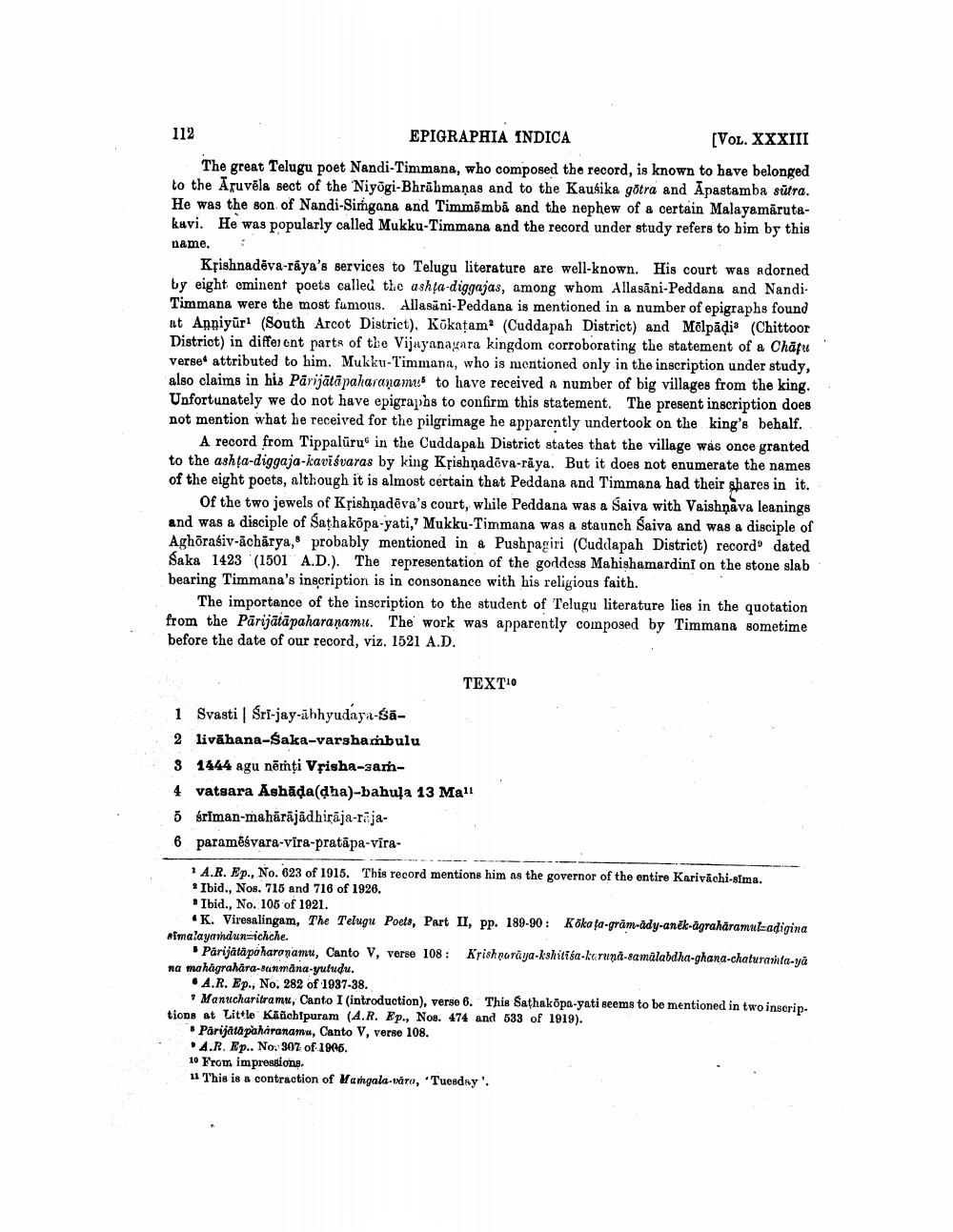________________
112
EPIGRAPHIA INDICA
[VOL. XXXIII
The great Telugu poet Nandi-Timmana, who composed the record, is known to have belonged to the Aruvēla sect of the Niyogi-Bhrähmanas and to the Kausika götra and Apagtamba sūtra. He was the son of Nandi-Singana and Timmămba and the nephew of a certain Malayamārutakuvi. He was popularly called Mukku-Timmana and the record under study refers to him by this name. :
Křishnadēva-rāya's services to Telugu literature are well-known. His court was adorned by eight ominent poets called the ashta-diggajas, among whom Allasāni-Peddana and Nandi. Timmans were the most famous. Allasäni-Peddana is mentioned in a number of epigraphs found at Anniyūri (South Arcot District). Kökatam (Cuddapah District) and Molpädi (Chittoor District) in different parts of the Vijayanagara kingdom corroborating the statement of a Chafu verse attributed to him. Mukku-T'immana, who is mentioned only in the inscription under study, also claims in his Pārijātā paharanams to have received a number of big villages from the king. Unfortunately we do not have epigraphs to confirm this statement. The present inscription does not mention what he received for the pilgrimage he apparently undertook on the king's behalf.
A record from Tippalūru in the Cuddapah District states that the village was once granted to the ashta-diggaja-kavisvaras by king Kpishṇadēva-raya. But it does not enumerate the names of the eight poets, although it is almost certain that Peddana and Timmana had their shares in it.
of the two jewels of Kțishṇadēva's court, while Peddana was a Saiva with Vaishnava leanings and was a disciple of Sathaköpa-yati, Mukku-Timmana was a staunch Saiva and was a disciple of Aghorasiv-acharya, probably mentioned in a Pushpagiri (Cuddapah District) recordo dated Saka 1423 (1501 A.D.). The representation of the goddess Mahishamardini on the stone slab bearing Timmana's inscription is in consonance with his religious faith.
The importance of the inscription to the student of Telugu literature lies in the quotation from the Pārijatāpaharanamu. The work was apparently composed by Timmana sometime before the date of our record, viz. 1521 A.D.
TEXTιο
1 Svasti | Sri-jay-ābhyudaya-śā2 livāhana-Saka-varshambulu 3 1444 agu nēmți Vpisha-sam4 vatsara Ashāda(dha)-bahuļa 13 Mali 5 briman-mahārājādhirāja-raja6 paramèśvara-vira-pratāpa-vira
1 A.R. Ep., No. 623 of 1915. This record mentions him as the governor of the entire Karivāchi-síma. Ibid., Nos. 715 and 716 of 1926. Ibid., No. 105 of 1921.
K. Viresalingam, The Telugu Poets, Part II, pp. 189-90: Koka ga-gram-ddy-anek-agraharamul-adigina simalayandunrichche.
Parijatapoharonamu, Canto V, verse 108: Krisk parāya-kshitisa-kuruna-samalabdha-ghana-chaturanita-ya na mahägrahara-san mana-yutudu.
• A.R. Ep., No. 282 of 1937-38.
Manucharitramu, Canto I (introduction), verse 6. This Sathakopa-yati seems to be mentioned in two inseriptions at Little Kanchipuram (A.R. Ep., Nos. 474 and 633 of 1919).
• Parijatapaharanamu, Canto V, verse 108.
4.R. Ep.. No. 307 of 1996. 10 From impressions. 11 This is a contraction of Mangala-varo, Tuesday'.




